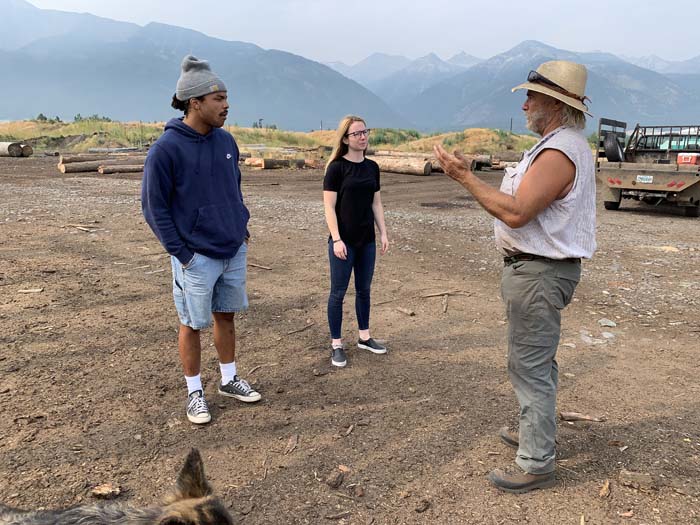REV Center research to help local economies
Published 6:45 am Tuesday, October 27, 2020

- Quincy Backes and Sarah Buddingh, Eastern Oregon University student interns at the Rural Engagement and Vitality Center, visit with Jim Zacharias, owner of Jayzee Lumber in Joseph in August. The visit gave the students a chance to learn about the timber/lumber industry as part of a project to gather data on how the Blue Mountains Forest Plan could affect local economies.
EASTERN OREGON — Local economies will receive a boost in data that could benefit them and provide vital information to the U.S. Forest Service and its effort to create a multi-use plan for the national forests in the Blue Mountains.
The Rural Engagement and Vitality Center, a partnership between Eastern Oregon University and Wallowa Resources, is working to collect data to better understand the the economic effects of the U.S. Forest Service’s Blue Mountains Forest Plan. The Blues Intergovernmental Council, a subcommittee of the Eastern Oregon Counties Association, is spearheading the project.
The Forest Service and Eastern Oregon Counties Association are finalizing the plans for collecting the data.
Two Eastern Oregon University economics professors, Peter Maille and Scott McConnell, are leading the socioeconomics portion of the research with a rotating intern each quarter. Nils Christoffersen, director of Wallowa Resources, and REV Center Program Manager Julie Keniry are also helping in these efforts for Wallowa County.
“We came together to create a plan specific to our regions and local economies,” McConnell said.
One of the factors that led to the REV formation was an objection to the way the Forest Service conducted an economic analysis of the redrawn forest plan revision. The analysis didn’t give a full scope of the impact of locations not on a main thoroughfare and failed to take into account specifics of local economies.
“The economic analysis was done down the (Interstate) 84 corridor. If that is where you are going for your economic analysis you are missing a lot of the economy. That is where we had pushed and that is where we got started,” said Wallowa County Commissioner Susan Roberts. “(We want) to do an economic analysis of the affected counties and the communities within those counties.”
Union County Commissioner Paul Anderes said the research will provide a more accurate depiction of how forest policies effect the local economy.
“In the original forest service plans, the socioeconomic impact was too broad and generalized,” Anderes said. “This new plan can include the countywide profile of socioeconomic status, specifically for communities within rural Eastern Oregon.”
The research and data will provide more context for the impact of the plans.
“The Forest Service cannot get into each community, but we can,” McConnell said.
The project will include data from 10 counties in Oregon and four in Southeast Washington, according to a press release from EOU. The updated analysis plan will include counties, such as Wallowa County, that do not have a main traffic vein, and Union County, which is full of communities that will be impacted by the forest plan.
The intent is for the analysis to be more than just a glance at the counties as a whole. Maille said the plan also is to involve counties and communities in the discussion so the data will be an accurate reflection of how the people living in these areas feel about and experience use of the forest.
Anderes said Union County commissioners selected cities in the county where timber mills continue to run or have closed down, including Elgin, Union, North Powder and La Grande.
Christoffersen also spoke about the importance of a more in-depth analysis for the counties, noting it would prevent viewing the economic impact of forest management decisions through one lens.
“The desire was to create a system to get more localized analysis of what would be the impact of increasing or decreasing timber harvest on national forest land, (or) increasing or decreasing the grazing activities,” he said. “(It’s) trying to understand the relative economic importance of the national forest system land and their management to the economics of the Eastern Oregon counties.”
He explained that counties with a diverse economy — such as Umatilla County, which has, he said, industrial activity along the Columbia River, farming, the Pendleton Round-up and Blue Mountain Community College, for example — are going to experience different effects than a county that has a large portion of land in the forest system. He noted 58% of Wallowa County land is national forest land and the county has a strong ag, ranching and forest sector, plus a number of small businesses related to forest management and forest contracting.
“You have, in one sense, winners and losers in any decision like that, or sectors that would benefit,” he said. “If they, for example, decided to increase timber harvest as a hypothetical, those counties that still have sawmills would benefit the most, and those counties that have a strong forest service would still have a benefit.”
He said this process is to inform the Forest Service about the values and priorities in Northeast Oregon that can then help inform the future management.
“At the same time, we’re going to try to be creative and promote innovation about how our communities try to take advantage of the opportunities that different management decisions in the National Forest Service offer,” Christoffersen said.
McConnell said this project also is a good way to discover a county’s ability to resist or reduce shock to its system through management tactics.
According to Keniry, the U.S. Forest Services and Eastern Oregon Counties Association provided $105,000 in funding. The plan is to complete the project within that funding amount in one to two years.





